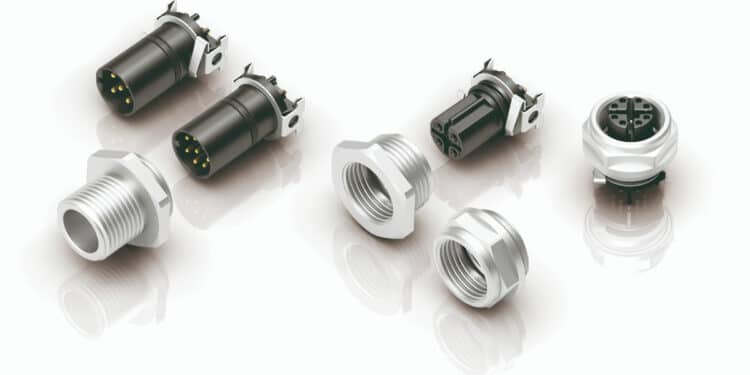binder, a leading supplier of industrial circular connectors, offers products from several M12 series as surface mount devices (SMDs).
They are suitable for further processing in fully automated processes, such as for the particularly dense, double-sided assembly of PCBs. These are used in automation technology devices, sensors and actuators as well as in robotics.
Several M12 connector series from binder are available in versions for surface mount technology (SMT). On the one hand, they are advantageous for integration into space-critical designs, on the other hand, the good automation capability in further processing offers enormous savings potential.
SMDs: Space-saving and economical to process
In the course of miniaturizing electronic assemblies, surface mounting has proven itself in component assembly with high component density. In contrast to the classic through-hole technology (THT) or through-hole reflow (THR) process, the SMD contact pins are placed directly on the surface in the SMT process and connected using solder paste instead of being inserted through the PCB and then soldered. This allows significant space savings to be made: for example, many connectors can be mounted with very small distances in one plane, as is required for passive/active sensor distributors in automation technology.
SMDs are usually supplied on so-called blister tapes (tape & reel) – a type of packaging that is suitable for automated further processing by the customer. In addition to space-saving PCB assembly, this ability to automate production is a significant advantage of surface mounting. It is characterized by its cost-effectiveness, especially for large quantities or when several connectors are to be processed on one PCB. Furthermore, advantages can be achieved in terms of heat dissipation and signal integrity as well as a reduced susceptibility to errors during assembly.
SMT product variety from binder
The binder SMT products are available in versions with 4, 6 and 8 contacts and with different codings. They are available in both shielded and unshielded versions. The M12 connectors are also available in different versions – for example as a set with different flange housings, as a built-in part in blister packaging or tape & reel packaging for automated processing.
In detail, these are A-coded M12 connectors from the 713/763 series, B-coded components from the 715/766 series and connectors from the 825/876 series with D-coding and the 876 series with X-coding.
Depending on the coding, the M12-SMT variants are suitable for different applications: A-coded for sensors and DC power, B-coded for Profibus and D- and X-coded for 100 Mbit and 10 Gbit Ethernet respectively.
All M12 products from binder provide industry-relevant protection acc. to IP67 against the ingress of dust and water. The binder variants are based on the current market standards with regard to the PCB drilling pattern, which means that switching to binder products requires little effort.






